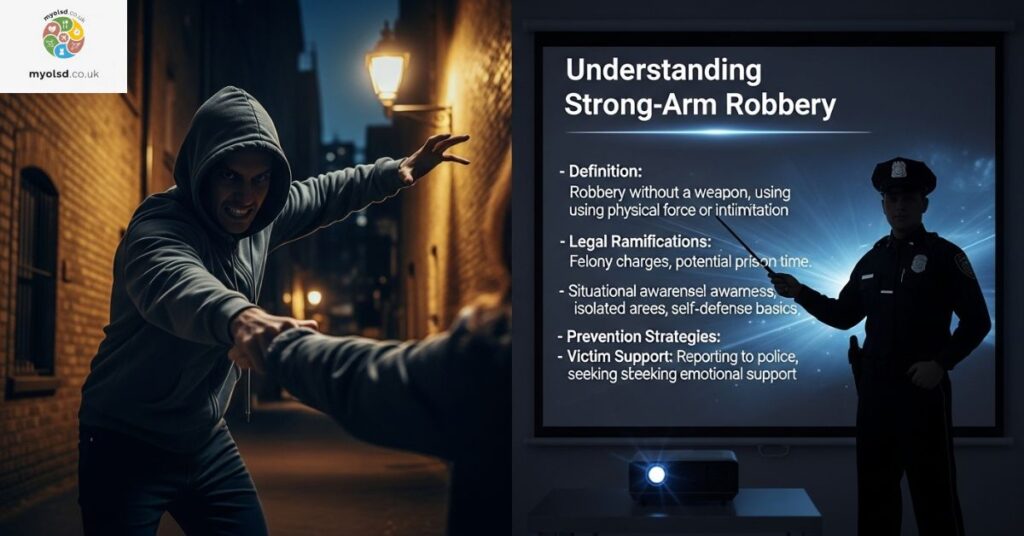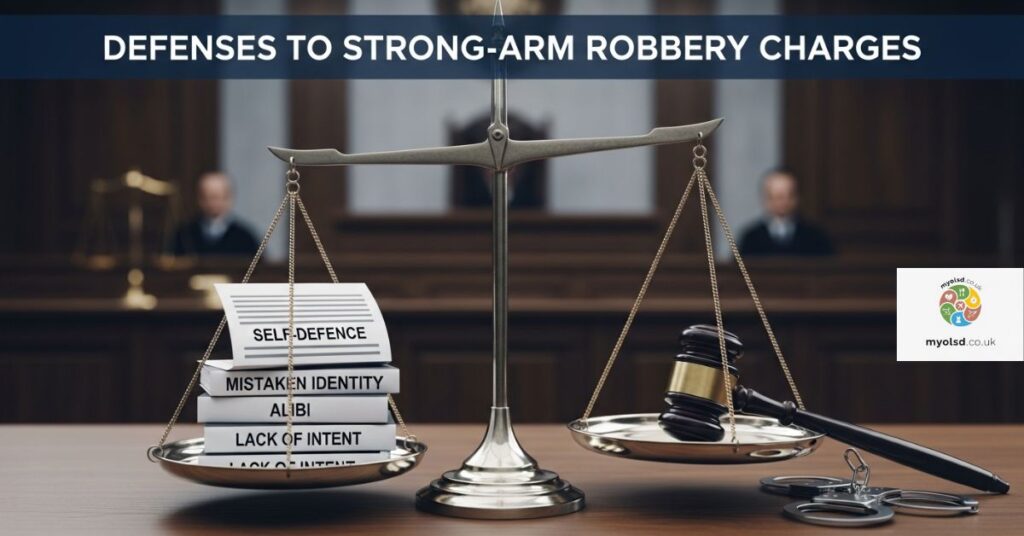Ever heard the term strong-arm robbery and wondered what it actually means? I remember the first time I saw it in the news and thought it must involve weapons or something extreme. It’s scary not knowing how serious a charge or crime really is, especially when you’re just trying to make sense of what you read or hear. If you’re feeling confused or uneasy about this term, you’re definitely not alone.
In this post, we’ll break down what strong-arm robbery is in simple, clear language. You’ll learn exactly what it means, how it’s different from other types of robbery, and why it carries serious consequences even without weapons. By the end, you’ll have a clear understanding of the term and feel more confident knowing the facts.
Understanding Strong-Arm Robbery

Definition of Strong-Arm Robbery
Strong-arm robbery (sometimes written “strong-arm robbery”) is a type of robbery where a person takes property from another using physical force, intimidation, or threats, but without a deadly weapon. It’s still considered robbery because force or fear is used to take property directly from someone else, but it’s not as severe as armed robbery.
For example:
- Someone pushes another person and snatches their wallet.
- A thief yanks a bag off someone’s shoulder while threatening to hit them.
Both of these would likely be strong-arm robbery because physical force or intimidation was involved, but no weapon was used.
Strong Arm Robbery vs. Simple Theft
Many people confuse strong-arm robbery with theft or shoplifting. The difference lies in confrontation.
- Theft/Larceny: Property is taken without direct contact or threats (e.g., stealing from a store shelf).
- Strong Arm Robbery: Force, fear, or threats are used to take property directly from a victim.
This makes strong-arm robbery a felony, while simple theft might be a misdemeanor depending on the value of the property.
Strong-Arm Robbery vs. Armed Robbery

Key Differences
- Armed Robbery: A deadly weapon (gun, knife, or even an object believed to be deadly) is used or threatened.
- Strong Arm Robbery: No deadly weapon is used; force or intimidation alone is enough.
In legal terms, strong-arm robbery is a lesser included offense of armed robbery. If prosecutors can’t prove the use of a weapon, the charge may be reduced to strong-arm robbery.
Read More Article:LOI in Real Estate Made Easy
Examples
- Armed Robbery: Pretending to have a gun while robbing a store.
- Strong Arm Robbery: Punching someone to steal their phone without using a weapon.
Penalties for Strong-Arm Robbery
The penalties for strong-arm robbery vary by state, but it’s always a serious felony. Here are some examples:
- South Carolina: Up to 15 years in prison; no mandatory minimum. Probation may be possible.
- Virginia: Up to 10 years in state prison.
- Texas: Treated as a variant of aggravated robbery without a weapon.
Even though it’s considered less severe than armed robbery, strong-arm robbery can still result in:
- Prison time
- Fines
- Probation
- A permanent criminal record that affects jobs, housing, and education
Because of these consequences, anyone facing this charge should take it seriously and consult a criminal defense attorney.
Defenses to Strong-Arm Robbery Charges

A criminal charge is not a conviction. Prosecutors must prove their case beyond a reasonable doubt, and several defenses may apply.
1. Innocence or Mistaken Identity
This is the most common defense. If you didn’t commit the crime or were wrongly identified, your lawyer can challenge the evidence, eyewitness accounts, or surveillance footage. Eyewitness misidentification happens often, especially under stress.
2. Lack of Intent
Robbery requires intent. If you didn’t intend to use force or take someone’s property, the prosecution’s case weakens.
3. Self-Defense
If you used force to protect yourself but didn’t intend to rob someone, your lawyer can argue self-defense.
4. Duress or Coercion
If someone forced you to commit a robbery under threat of harm or death (duress), that can be a valid defense. For example, if someone threatened to harm your family unless you stole something, your lawyer may argue duress.
5. Alibi
If you can prove you were somewhere else when the robbery occurred, the charges may be dismissed.
6. Involuntary Intoxication
While voluntary intoxication isn’t usually a defense, involuntary intoxication (such as being unknowingly drugged) can be used to challenge intent.
How Prosecutors Build a Case
Prosecutors must show:
- The accused took property directly from a person.
- Force, intimidation, or threats were used.
- No deadly weapon was involved (otherwise it’s armed robbery).
- The accused intended to commit robbery.
They may use:
- Eyewitness testimony
- Surveillance footage
- Confessions
- Physical evidence
Because the burden of proof is high, a skilled defense lawyer can often create reasonable doubt.
Consequences of a Conviction
A strong-arm robbery conviction can have long-lasting effects:
- Prison time (up to 10 to 15 years, depending on state law)
- Fines and restitution to victims
- Permanent criminal record, affecting jobs, housing, and professional licenses
- Loss of civil rights (such as voting or firearm ownership in some states)
For younger defendants, some states offer programs like the Youthful Offender Act (YOA), which may allow probation or eventual expungement if conditions are met.
What to Do If You’re Charged With Strong-Arm Robbery

- Do Not Speak to Police Without a Lawyer
Anything you say can be used against you. Politely decline to answer questions until your attorney is present. - Hire an Experienced Criminal Defense Lawyer
Find someone who specializes in robbery and violent crime cases. They’ll know local procedures, plea options, and defenses. - Gather Evidence for Your Defense
This could include witnesses, receipts, phone records, or anything proving your alibi. - Follow All Court Orders
Missing court dates or violating conditions can make your situation worse.
Why Legal Representation Matters
Robbery charges are serious, and even though strong-arm robbery is less severe than armed robbery, it still carries heavy penalties. A good lawyer can:
- Challenge the prosecution’s evidence
- Negotiate a plea deal to a lesser charge
- Argue for probation instead of prison
- Protect your rights throughout the process
Real-Life Example Scenarios

- Scenario 1: Someone shoves another person and grabs their phone. No weapon involved. Likely strong-arm robbery.
- Scenario 2: Someone points what appears to be a gun at a cashier, but it’s actually a toy. This may still be charged as armed robbery because the victim believed it was deadly.
- Scenario 3: A person is forced by a gang member to snatch a purse under threat of harm. A defense lawyer may argue duress.
These examples show how the same act can lead to different charges depending on the circumstances.
Key Takeaways
- Strong-arm robbery = Robbery without a deadly weapon but with force or intimidation.
- It’s a felony, but a lesser charge than armed robbery.
- Penalties can include up to 10 to 15 years in prison and a permanent criminal record.
- Defenses include innocence, lack of intent, self-defense, duress, and alibi.
- Having legal representation can significantly impact the outcome
Facing a Strong-Arm Robbery Charge?

If you or someone you know is facing strong-arm robbery charges, the stakes are high. The right defense strategy can protect your future. Experienced criminal defense attorneys understand how to challenge evidence, question eyewitnesses, and negotiate for reduced penalties or dismissal.
Final Thoughts
Understanding what strong-arm robbery is helps you know your rights and options. While it’s a serious crime, it’s not as severe as armed robbery, and there are defenses available. Don’t face these charges alone — speak to a qualified attorney to discuss your case.
FAQS
What is the definition of a strong-arm robbery?
Taking property directly from someone using force or intimidation, but without a deadly weapon.
What is an armed robbery?
A robbery in which a deadly weapon was used or its use was threatened
What does strong-arm mean in law?
Using physical force or threats instead of a weapon to commit a crime.
What is the most feared type of robbery?
Armed robbery, because it involves deadly weapons and higher risk of harm.

